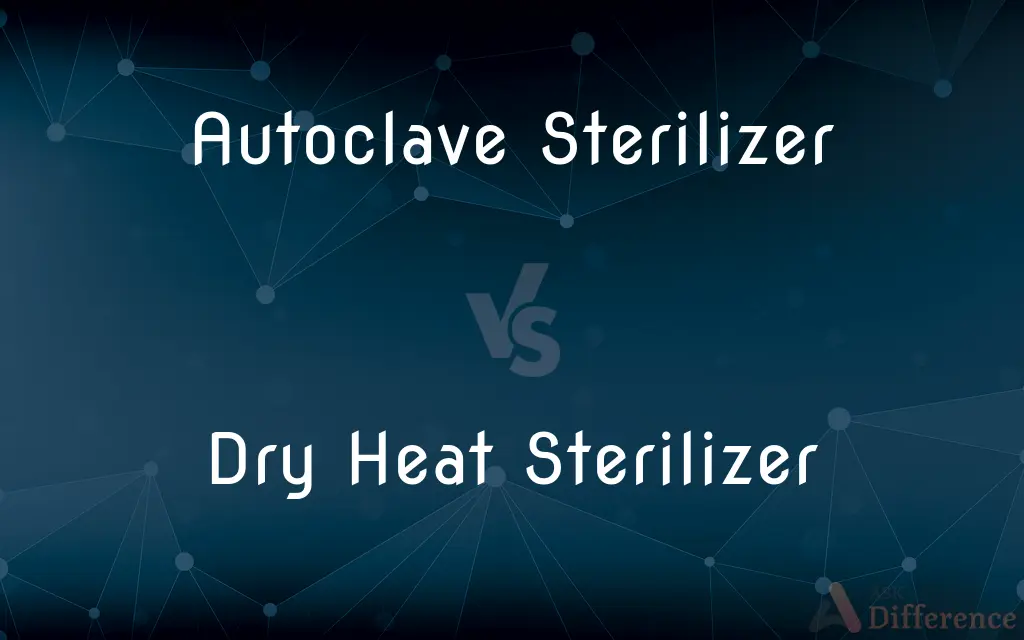Autoclave Sterilizer vs. Dry Heat Sterilizer — What's the Difference?
By Tayyaba Rehman — Published on January 22, 2024
An autoclave sterilizer uses pressurized steam to sterilize equipment, ideal for heat and moisture-resistant items. A dry heat sterilizer uses hot air, suitable for moisture-sensitive or heat-stable items.

Difference Between Autoclave Sterilizer and Dry Heat Sterilizer
Table of Contents
ADVERTISEMENT
Key Differences
Dry Heat Sterilizer uses high temperatures, typically ranging from 160°C to 170°C, applied over an extended period, which is effective for materials that might be damaged by moist heat. It's ideal for sterilizing items that are moisture-sensitive or cannot be sealed.
Autoclave Sterilizers are preferred for sterilizing surgical instruments, glassware, and items that can withstand high temperatures and pressure without damage. Dry Heat Sterilizers are better for oils, powders, and other items that could be adversely affected by steam, such as sharp instruments that might corrode.
The sterilization time in an Autoclave Sterilizer is generally shorter due to the efficiency of steam under pressure. In contrast, Dry Heat Sterilizers require longer exposure times, as dry heat penetrates materials more slowly than moist heat.
Maintenance and operational costs can vary between the two. Autoclave Sterilizers might require more regular maintenance due to their complex mechanism involving steam and pressure. Dry Heat Sterilizers tend to be simpler in design, potentially offering lower maintenance requirements.
Comparison Chart
Method of Sterilization
Steam under pressure
High temperature dry heat
ADVERTISEMENT
Suitable Materials
Surgical instruments, glassware
Oils, powders, sharp instruments
Sterilization Time
Shorter due to efficiency
Longer exposure times required
Ideal Use
Moisture-resistant items
Moisture-sensitive, heat-stable items
Maintenance
Regular maintenance needed
Lower maintenance requirements
Compare with Definitions
Autoclave Sterilizer
Commonly used in medical and laboratory settings.
In the lab, we use an autoclave sterilizer to prepare our culture media.
Dry Heat Sterilizer
Suitable for materials that might be damaged by moist heat.
We used a dry heat sterilizer for surgical instruments with electronic components.
Autoclave Sterilizer
An autoclave sterilizer uses pressurized steam to sterilize equipment and supplies.
The surgical tools were sterilized in an autoclave sterilizer before the procedure.
Dry Heat Sterilizer
Used in dental clinics, labs, and places requiring sterilization of heat-stable materials.
The lab's dry heat sterilizer is essential for preparing certain lab tools.
Autoclave Sterilizer
It operates at high temperatures and pressures to achieve sterilization.
The autoclave sterilizer reached a temperature of 121°C to ensure all bacteria were destroyed.
Dry Heat Sterilizer
It sterilizes through the process of oxidation.
The dry heat sterilizer effectively sterilizes by oxidizing microorganisms.
Autoclave Sterilizer
Effective for sterilizing heat-resistant, non-porous items.
The dental clinic relies on an autoclave sterilizer for their instruments.
Dry Heat Sterilizer
A dry heat sterilizer uses high temperature without moisture or pressure.
The dry heat sterilizer is ideal for sterilizing powders and oils that cannot be exposed to moisture.
Autoclave Sterilizer
Autoclaves use water to generate steam for the sterilization process.
The autoclave sterilizer needs to be filled with distilled water before starting the cycle.
Dry Heat Sterilizer
Typically operates at temperatures above 160°C.
To sterilize the glassware, we used a dry heat sterilizer set at 170°C.
Common Curiosities
Can a dry heat sterilizer sterilize liquids?
No, liquids cannot be sterilized in a dry heat sterilizer as it uses dry heat and is suitable for dry materials.
What items should not be sterilized in a dry heat sterilizer?
Items sensitive to high temperatures or prone to melting, like some plastics, should not be sterilized in a dry heat sterilizer.
Is an autoclave sterilizer faster than a dry heat sterilizer?
Generally, autoclaves are faster than dry heat sterilizers due to the efficiency of steam sterilization.
How do autoclave sterilizers kill microorganisms?
Autoclave sterilizers kill microorganisms using pressurized steam at high temperatures.
What is the typical sterilization temperature for an autoclave?
The typical sterilization temperature for an autoclave is around 121°C (250°F) to 134°C (273°F).
Can dry heat sterilizers be used for cloth or fabric?
Dry heat sterilizers are not recommended for cloth or fabric, as these materials may be damaged by the high temperatures.
Are autoclave sterilizers safe for all medical instruments?
Autoclaves are safe for most medical instruments, especially those made of metal and resistant to heat and moisture. However, some materials, like certain plastics, can be damaged in autoclaves.
What types of items are best sterilized in a dry heat sterilizer?
Items like oils, powders, and certain metal instruments that might be damaged by moisture are best sterilized in a dry heat sterilizer.
How is the effectiveness of sterilization verified in an autoclave?
The effectiveness can be verified using biological indicators, chemical indicators, or mechanical monitoring of temperature and pressure.
How long does it take to sterilize equipment in an autoclave?
The time varies but generally ranges from 15 to 30 minutes, depending on the items and the autoclave model.
Are dry heat sterilizers energy-efficient?
While effective, dry heat sterilizers typically consume more energy than autoclaves due to the higher temperatures and longer cycle times.
Do autoclave sterilizers require regular maintenance?
Yes, autoclave sterilizers require regular maintenance to ensure proper functioning and safety, including cleaning and pressure gauge checks.
Is there a risk of items burning in a dry heat sterilizer?
There is a risk of burning or charring items if a dry heat sterilizer is not properly monitored or if items are left in it for too long at high temperatures.
Is specialized training required to operate an autoclave sterilizer?
Basic training is recommended to ensure proper operation and safety when using an autoclave sterilizer.
Can rubber items be sterilized in a dry heat sterilizer?
Rubber items are generally not suitable for dry heat sterilization as high temperatures can cause deformation or melting.
Share Your Discovery

Previous Comparison
Political Science vs. Sociology
Next Comparison
CML vs. SMLAuthor Spotlight
Written by
Tayyaba RehmanTayyaba Rehman is a distinguished writer, currently serving as a primary contributor to askdifference.com. As a researcher in semantics and etymology, Tayyaba's passion for the complexity of languages and their distinctions has found a perfect home on the platform. Tayyaba delves into the intricacies of language, distinguishing between commonly confused words and phrases, thereby providing clarity for readers worldwide.














































